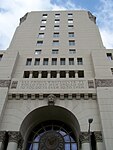Precious Blood Catholic Church (Los Angeles)
20th-century Roman Catholic church buildings in the United StatesFilipino-American culture in CaliforniaHispanic and Latino American culture in Los AngelesRoman Catholic churches completed in 1926Roman Catholic churches in California ... and 4 more
Roman Catholic churches in Los AngelesRomanesque Revival church buildings in CaliforniaWallace Neff buildingsWestlake, Los Angeles

Precious Blood Catholic Church is a Roman Catholic church and parish in the Los Angeles Archdiocese, Our Lady of the Angels Pastoral Region. The church is located one block north of Lafayette Park at 435 South Occidental Boulevard in the Westlake section of Los Angeles, California. The current Italian Romanesque church structure was dedicated in 1926.
Excerpt from the Wikipedia article Precious Blood Catholic Church (Los Angeles) (License: CC BY-SA 3.0, Authors, Images).Precious Blood Catholic Church (Los Angeles)
South Occidental Boulevard, Los Angeles Westlake
Geographical coordinates (GPS) Address External links Nearby Places Show on map
Geographical coordinates (GPS)
| Latitude | Longitude |
|---|---|
| N 34.065 ° | E -118.28388888889 ° |
Address
Church of the Precious Blood
South Occidental Boulevard
90057 Los Angeles, Westlake
California, United States
Open on Google Maps








